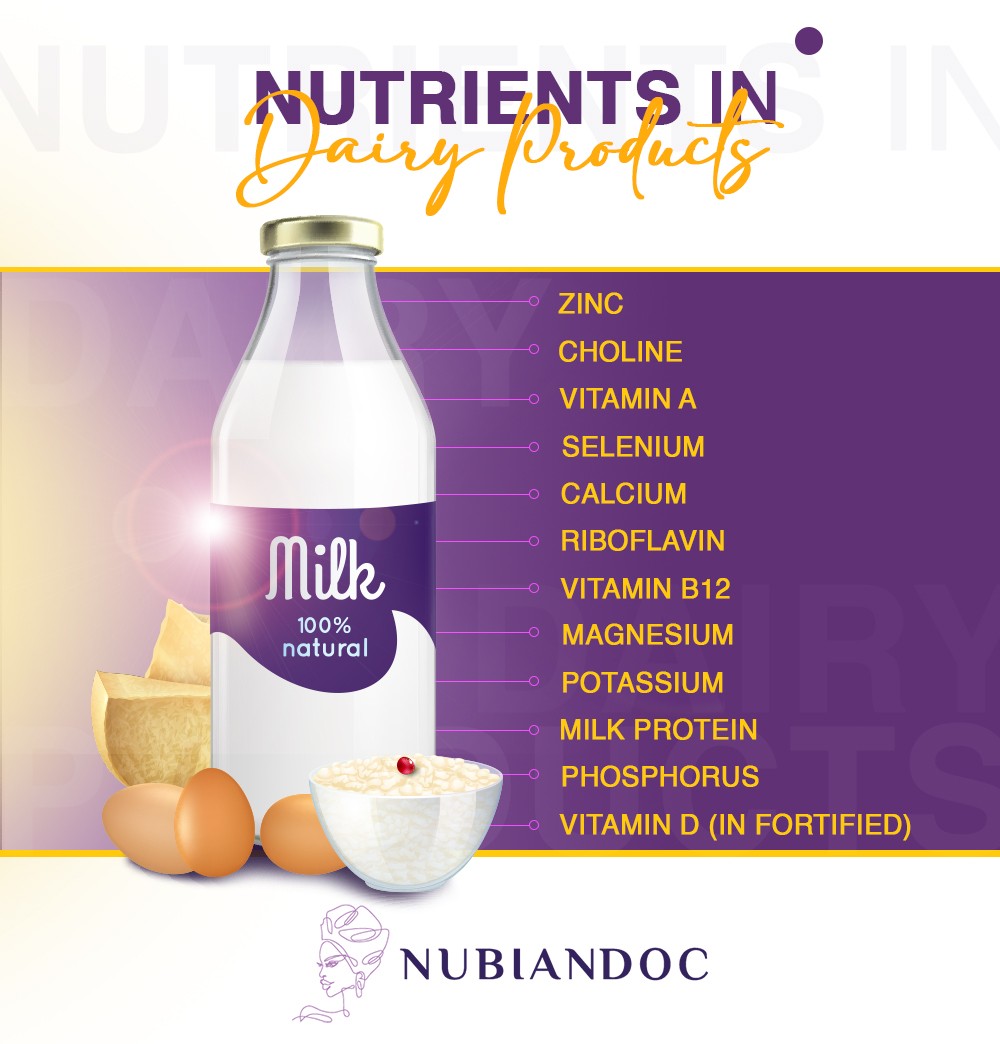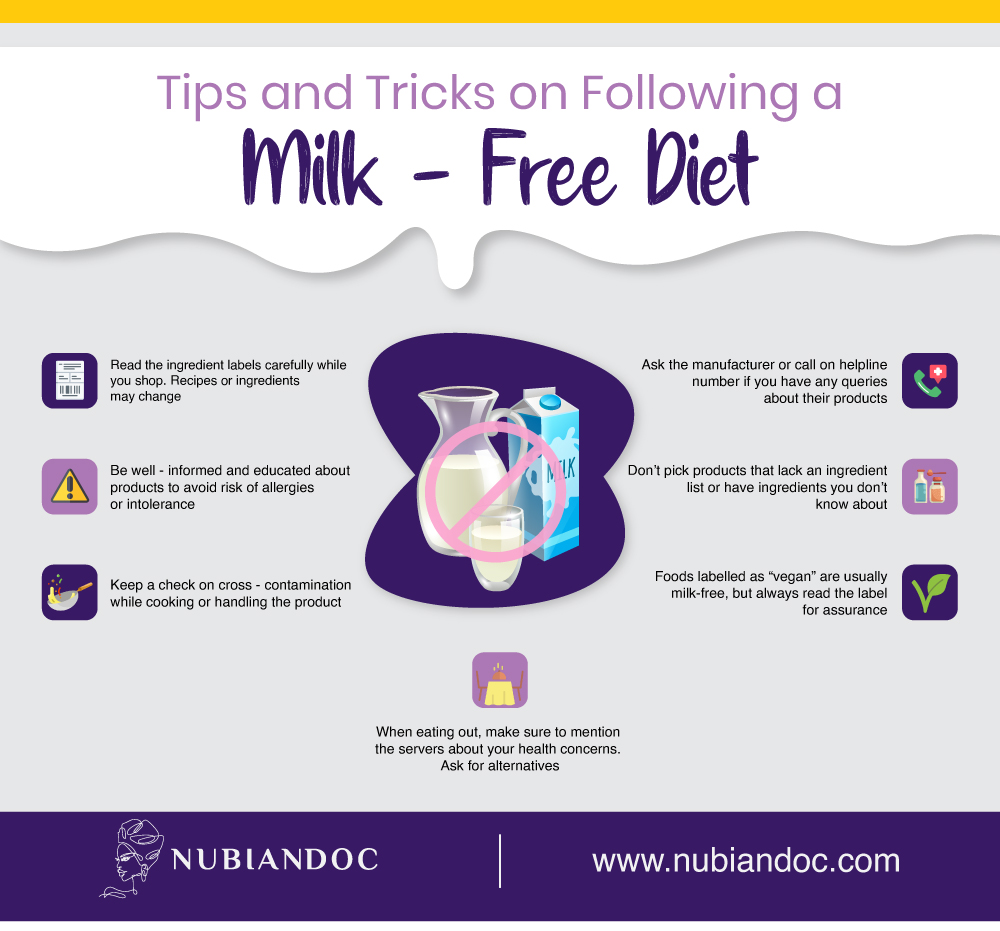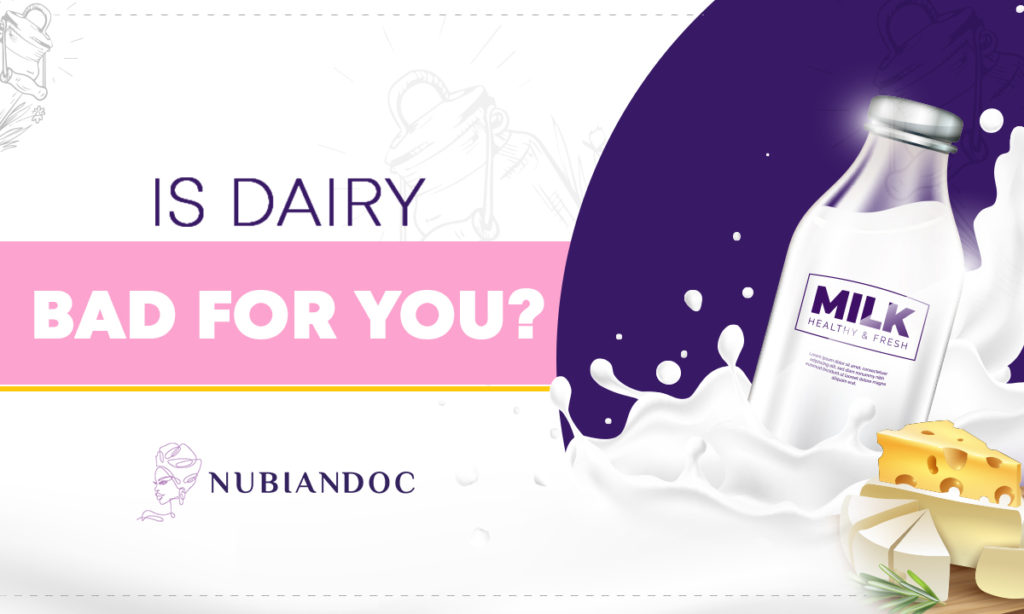Dairy Products | Nutrients | History of Dairy | Can It Cause Allergies? | Can It Cause Cancer? | Lactose Intolerance vs. Dairy Allergy | Symptoms | Milk-free Diet | Is Lactose Intolerance Genetic? | How to Increase Tolerance | Alternatives | Non-Dairy Alternatives to Cow’s Milk | Tolerance-Inducing Dairy Meals | Dairy Free Recipes | Bottom Line
Dairy products are categorized as ‘nutrient-dense’ foods that contain macronutrients and micronutrients necessary for a healthy body. For this reason, health authorities such as the United States Department of Agriculture (USDA) advise on having a serving of dairy products daily.
Scientific evidence, however, on whether dairy is healthy or harmful is mixed as complexities exist behind the labels.
This article provides an in-depth look into dairy products, and explores how they may affect your health.
What Are Dairy Products?
“Dairy” refers to foods that are derived from milk or food which contains the milk of mammals, such as cows, sheep, goats, or buffalo.
Dairy products are multi-faceted and easily available in numerous forms-ranging from foods you can eat with fork or spoon to beverages you can sip on.
One of the most consumed dairy product is milk-an essential source of nutrition for people since the advent of time. Products made from milk include cheese, yogurt, kefir, butter and ice cream. These products are enriched with all the nutrients your body needs, such as protein, calcium and vitamin B12. They help with repairing and re-modeling muscle tissue, maintaining strong bones and teeth, and even keeping the nervous system functioning at full capacity. Moreover, the protein, zinc, selenium and vitamins A & D found in dairy provides the nutrition to support the immune system. It should be noted that vitamin A and D is actually added to milk produced in the US. This fortification process was initiated in the 1930s to decrease the prevalence at that time of bone disorders caused by vitamin deficiency. Milk, in essence, consists of water, carbohydrates (lactose-a natural sugar), fat (unless the milk is non-fat, skim milk), vitamins, minerals and protein.
Summary: Milk is one of the most consumed dairy products, and is also an essential source of nutrition for people since the advent of time. Products made from milk include cheese, yogurt, kefir and butter-all which bring a range of health benefits upon consumption.

A Brief History of ‘Dairy’
Dairy farming modernization began in the 1900’s, after the rise of Dairy Industry inventions and the use of pasteurization techniques to sterilize and remove harmful bacteria from milk.
In the early 1600’s, North American immigrants brought cattle from Europe to feed their families. By the 1800’s, cattle breeds were specifically utilized for dairy production. During this era, milk and dairy products became popular for local feeding.
Massive production of quality dairy products was required during this time, as people began settling into cities in the late 1800’s. Pasteurization equipment, milking machines, refrigerated milk-tank cars, automatic bottling machines and commercial milk bottles were made during this time growing the dairy industry for mass consumption.
Summary: Dairy farming modernization began in the 1900’s, after pasteurization equipment, milking machines, refrigerated milk-tank cars, automatic bottling machines and commercial milk bottles were invented for the growth of the milk industry.
Can Eating Dairy Cause Allergies?
2-3% of children less than three years of age are allergic to dairy products. The majority of them outgrow the allergy by the time they turn three. However, the latest research has indicated that this hasn’t been the case. In a study, fewer than 20% of children had outgrown the allergy by four years of age, and almost 80% were deemed likely to outgrow their allergies before they turned the age of 16. Milk is a commonly known food allergen, and can occur in both formula-fed and breast-fed infants.
Summary: Milk is a commonly known food allergen, and can occur in both formula-fed and breast-fed infants.
Can Milk and Dairy Products Cause Cancer?
According to fairly new research, consumption of dairy is linked with an increased risk of breast cancer ( hormone-responsive cancer ) in women and prostate cancer in men. High fat content present in dairy products and traces of growth hormones in milk may increase the risk of both breast and prostrate cancer. Similarly, according to Loma Linda University Adventist Health Sciences Center’s research, an increased intake of dairy calories can increase the risk of such cancers.
Consumption of dairy can also lead to higher blood levels of a hormone, insulin-like growth factor-1 (IGF-1), which is thought to promote the growth of certain cancers.
Many individuals consume dairy and as mentioned it’s promoted as an essential food by the USDA. With the pros and the cons weighed it is best to consider that dairy is a significant source of saturated fat in the american diet and should at the very least be minimized to avoid increased risk of obesity, heart disease and other risks associated with saturated fat consumption. Therefore opt for low fat milk or nondairy alternatives.
Lactose Intolerance vs. Dairy Allergy
The confusion between ‘lactose intolerance’ and ‘dairy allergy’ is quite common as most people are unable to differentiate between the two. While lactose intolerance involves the digestive system, a dairy allergy has more to do with the immune system. A lactose intolerant person’s body can’t make ‘lactase’, the enzyme required to digest lactose. We digest most foods by mechanical digestion (chewing) and chemical digestion ( digestive enzymes that speed chemical reactions making our food into smaller substances more absorbable). Lactose is the natural sugar found in milk-that forms when two other sugars-glucose and galactose-join together. Lactase, the enzyme breaks those chemical bonds of lactose into them smaller sugars.
Instead of normal digestion in your small intestine, undigested lactose travels into your colon, where it’s broken down by bacteria and causes bloating and gas. Even though it isn’t life threatening, its symptoms can be uncomfortable.
Lactose intolerance is mostly observed in adults. Beginning at the age of 20 or above, approximately 30 million Americans are affected according to recent studies. Its more commonly observed in people from Asian, Africa or Native American groups and rare in individuals from northern and western Europe. Dairy allergies involve the immune system instead of digestive system. A person with a dairy allergy reacts to proteins found in milk and other dairy products. Dairy products release substances that leads to allergy symptoms. These symptoms may vary in individuals differently-from mild to severe- which may present as a rash or which can lead to narrowing of the airway, breathing issues and, even worse, loss of consciousness and potentially death. Dairy allergies are more common in children, as many as two in every 100 (under the age of four) are suffering from this issue.
Summary: Lactose intolerance includes the digestive system and is more common in adults, whereas dairy allergies involve the immune system and are more commonly seen in children.
Symptoms of Dairy Allergy Vs. Lactose Intolerance
Below are a few noticeable symptoms of lactose intolerance. The severity depends on consumption and the level of tolerance an individual has.
Lactose Intolerance Symptoms
- Upset stomach
- Bloating
- Gas
- Diarrhea
- Nausea and Vomiting (sometimes)
- Flatulence
The symptoms of ‘milk allergy’ vary from one individual to another, and occurs within minutes to a few hours after the consumption of dairy.
Dairy Allergy Symptoms
- Hives
- Wheezing
- Itching or tingling feeling around the lips or mouth
- Swelling of the lips, tongue or throat
- Coughing or shortness of breath
- Vomiting
Signs that may take longer to develop are:
- Loose stools or diarrhea, which may contain blood
- Abdominal cramps
- Runny nose
- Watery eyes
- Colic, in babies
(Source: Mayoclinic)
Milk-free Diet”>

Is Lactose Intolerance Genetic?
Lactose intolerance is genetically inherited from your parents, who inherit it from theirs. For a majority of people, lactose intolerance begins to develop as a toddler and strengthens during adulthood. This happens because the body stops producing lactase, the enzyme responsible for breaking down the milk sugar-lactose.
When people use the term ‘lactose intolerance’, they’re often using a ‘collective term’ to describe distinctly different maladies-like maldigestion, intolerance, or an allergic response to cow’s milk and other dairy products.
Summary: Lactose intolerance is genetically inherited and it runs in families. For a majority of people, lactose intolerance begins to develop as a toddler and strengthens during adulthood. This happens because the body stops producing lactase, the enzyme responsible for breaking down the milk sugar-lactose.
How to Increase Tolerance for Lactose?
People with lactose intolerance might have milk cravings, despite knowing the health issues involved. If you or someone you know is lactose intolerant, you can work out a few options to still consume dairy.
Try out these simple tips to increase your tolerance level:
- Consume milk with other foods (instead of on an empty stomach) so it digests easily
- Consume smaller portions & gradually increase the quantity of milk you consume
- Prefer whole milk (instead of skimmed milk) because the fat in whole milk can help with the passage of dairy through your digestive system
- Acquire Lactase supplements. They are formulated to replace the missing enzyme. You can take this right before you plan on eating a meal consisting of dairy.
Alternatives for Lactose Intolerance
For starters, you can pick calcium-rich dairy options that eliminate cow’s milk.
Hard cheeses (including cheddar) contain small amounts of lactase, so they can mostly be consumed without the side effects linked with milk. Yogurts, on the other hand, have probiotics that help in digestion.
You may choose goat’s milk, which is about as close as you can get to cow’s milk. Goat’s milk has less amounts of milk protein (which leads to milk allergies), so it is generally tolerated well.
Summary: By picking food with a low amount of lactase and milk protein (such as yogurt, cheddar and goat’s milk), you can avoid milk allergies and lactose intolerance.
Non-Dairy Alternatives to Cow’s Milk
Milk that is obtained from plants does not include cholesterol as milk from animal produce, such as cow’s milk. Even though plant milk options have a different taste profile, they are similar to animal milk in form and function.
People have different taste buds. While some might prefer the taste of almond milk, for others it might be too nut-based. Below is a list of nondairy options to consider:
- Almond milk is made by grinding almonds in water, straining the pulp out. It is enriched with calcium and monounsaturated fat, which is also heart-healthy and low in calories.
- Coconut milk is made by mixing the grated ‘meat’ of a coconut in water. It is commonly used in cooking recipes, but can also be utilized as a drink.
- Hemp milk is obtained from hemp seeds soaked in water. It is similar to a cream, and is mostly used in coffee shops as an alternative for people intolerant or allergic to cow or soy milk.
- Oat milk is derived from hulled oat grains and water. It is nutrient rich and includes higher amount of calcium than a commonly used cup of milk.
- Rice milk is made by milling brown rice. It is fortified with calcium to meet the calcium levels found in cow’s milk, so you attain more nutrients and acquire a similar taste.
- Soy milk is made by soaking dried soybeans and later on grinding them in water. Commonly used for drinking and cooking, soy milk is a popular alternative with high nutritional content.
For animal-based dairy products, plant milk is the best “environmentally friendly” alternative. This dairy substitute’s sustainability depends on the amount of water used and CO2 produced per liter [for different kinds of milk].
| DAIRY SUBSTITUTES | ||
| Type of substitute | Water used ( liters ) | C02 emissions (kg) |
| Cow Milk | 628 | 3.2 |
| Almond Milk | 371 | 0.7 |
| Rice Milk | 270 | 1.2 |
| Oat Milk | 48 | 0.9 |
| Soy Milk | 28 | 1.0 |
(Source: Statista)
Summary: Coconut milk, almond milk, oat milk and soy milk are plant-based picks as an alternative to animal-based dairy products. Plant-based milk is good for health because of its reduced cholesterol levels.
How to Obtain Calcium & Vitamins from Diet After Eliminating Dairy
As milk is fortified with Vitamin D and is a major source of Calcium, it’s important to make sure the nutrients come through your diet if you’re not having it. Calcium can be obtained from leafy green vegetables, beans, peas and fish. As far as you’re meeting your nutritional needs, there isn’t any risk factor of eliminating milk from your diet.
10 Tolerance-Inducing Dairy Meals
Being lactose intolerant doesn’t mean you have to crave dairy for the rest of your life: these helpful recipes and tips might help you tolerate dairy with ease.
Mixed Berries and Banana Smoothie
For people with lactose intolerance, one hack is to take in dairy and combine it with other foods. Combining the foods make the absorption of the lactose insufficient, like in the given recipe of smoothie.
Ingredients
- 1 cup frozen mixed berries
- 1 frozen ripe banana
- 1/2 cup low-fat vanilla yogurt
- 1/4 cup orange juice
- 1 teaspoon honey (optional)
Directions
Put all ingredients together in a blender and puree until smooth.
Almond Butter Yogurt Dip
Tradition and Greek yogurt (both) have live and active cultures that aid in breaking lactose down for you. This means, in other words, that they’re simple to digest for people with lactose intolerance.
Ingredients
- 1/2 cup almond butter
- 1/2 cup plain Greek yogurt
- 2 tablespoons honey, plus extra for drizzling
- 1/2 teaspoon ground cinnamon
- 1/2 teaspoon vanilla extract
- Pinch of ground cardamom
- Pinch of sea salt
- Slivered almonds, for garnish
- Flaky sea salt, for garnish
- Sliced apples
Directions
In a medium bowl, mix almond butter, yogurt, honey, cinnamon, vanilla, cardamom and sea salt. Garnish it with slivered almonds, a drizzle of honey and flaky sea salt. This recipe can be served with sliced apples to make it tastier.
Strawberry Parfaits
Eating Greek yogurt may improve lactose digestion and tolerance.
Ingredients
- Strawberries
- Greek yogurt
- Sugar
- Cracker crumbs
- Honey
Directions
Put 1 quarter strawberries aside and mix with 1 teaspoon sugar in a large bowl. Sprinkle a layer of gingersnap crumbs or graham cracker crumbs at the bottom of the parfait glasses. Next, add 1 cup non-fat Greek Yogurt with 2 tablespoons honey and ½ teaspoon cinnamon into the mix. After putting berries in the mix, spread the Greek Yogurt mixture on top of the berries.
Summary: Even if you’re lactose intolerant, you can enjoy dairy with the help of these curated recipes given in our blog.

The Bottom Line
Dairy products are categorized as ‘nutrient-dense’ foods that contain macronutrients and micronutrients necessary for a healthy body. Products made from milk include cheese, yogurt, kefir, butter and even ice cream. These products are enriched with all the nutrients your body needs, such as protein, calcium and vitamin B12. They help with repairing and re-modeling muscle tissue, maintaining strong bones and teeth, and even keeping the nervous system functioning at full capacity. Moreover, the protein, zinc, selenium and vitamins A & D found in dairy products keep the immune system healthy and efficient.
Milk is a commonly known food allergen, and can occur in both formula-fed and breast-fed infants. For starters, if you have any dairy allergies, you can pick calcium-rich dairy options that eliminate cow’s milk. Hard cheeses (including cheddar) contain small amounts of lactase, so they can mostly be consumed without the side effects linked with milk. Yogurts, on the other hand, have probiotics that help in digestion.
Satisfy your dairy cravings with the curated recipes given in our blog, such as strawberry parfaits and smoothies.
You can follow recipes given in blog to satisfy your dairy cravings like preparing strawberry parfait or smoothies.
If you seek optimal health and need guidance, NubianDoc is here to help. With our customized meal plans and workout regimens, you are bound to be on the journey towards achieving a healthier lifestyle.
Also, checkout our informative articles on health and fitness.
Are dairy allergies and lactose intolerance the same issues or different?
In both problems, the complete elimination of dairy products from diet is required. Some of the symptoms overlap as well, lactose intolerance and dairy allergy are two separate terms. Lactose intolerance is observed mostly in infants and young children. It is basically the digestive system disorder. Dairy allergy, on the other hand, is the issue related to immune system and occurs mostly in adults.
What are the top three signs and symptoms of lactose intolerance?
Lactose intolerant sufferers are not able to fully digest the sugar that is present in the milk called as lactose which can lead to diarrhea, gas and bloating after eating or drinking dairy products. Lactose malabsorption is not dangerous or life threatening but it's symptoms can be very uncomfortable.
Can you suddenly become allergic to dairy?
It is quite uncommon to become allergic to milk proteins later in life. However, the development of lactose intolerance rises with the age.



